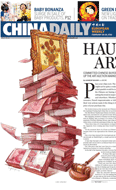Society
New Zealand quake toll rises to 113
Updated: 2011-02-25 07:34
(Agencies)
CHRISTCHURCH - Rescuers toiled for a fourth day among the ruins of New Zealand's quake-ravaged city of Christchurch on Friday, as hopes of finding more survivors faded and the death toll reached 113 with more than 200 missing.
Teams from quake-prone countries such as Japan and the United States helped in the search, using sniffer dogs and lowering microphones into collapsed buildings to probe for signs of life, two days after a 6.3 magnitude tremor struck the country's second biggest city.
| ||||
"For those people in those far off places, your families are our families, your children are our children. There is no difference for us," Christchurch Mayor Bob Parker said, promising searchers would not abandon hope.
Police said 228 people were listed as missing. The list could include many people whose bodies have been found but yet to be identified. More than 2,500 were injured in the quake, and more than 160 of them seriously.
Rescue efforts have been hampered by the possibility that aftershocks could bring down a teetering 26-storey hotel, triggering a domino effect and toppling other buildings.
Engineers were checking to see if an exclusion zone around it could be reduced to allow nearby buildings to be searched.
| ||||
"We'll keep searching until such time as we have satisfied ourselves beyond all possible doubt that there is no-one left still to rescue in terms of an active find," said fire rescue chief Jim Stuart Black.
Further international help was arriving on Friday from Britain, China and the United States, which will allow the search to be extended.
An American rescue worker, who helped in the Haiti quake rescue operation last year, said miracles were possible.
"We were pulling people out of the rubble seven or eight days after the Haiti quake," Brian Wells told Radio New Zealand.
"That's why we're here to find the live people still trapped and we're going to do everything we can to make that happen."
Rising toll
New Zealand Civil Defence Minister John Carter said the grim reality was that hope was fading.
"The last live rescue we had reported was Wednesday. We are still hopeful of course that there still may be people rescued but it's getting and less likely," Carter said.
An estimated 70 people had been rescued alive since the quake.
Police have released the names of only four of the dead, including two infants of five and eight months. More are due on Friday, but foreign reports have said two Britons, two Irish, and an Australian are also among the dead.
The worst fears centred on the six-story television building, with around 65 people still believed inside, including many missing Japanese and Chinese students, caught as floors pancaked down on to one another.
The landmark Christchurch Cathedral was also thought to have as many as between 16 and 22 bodies inside, and about eight are believed to be still inside a finance company building.
Japanese Chief Cabinet Secretary Yukio Edano said 26 Japanese students were still missing, while Taiwan said one of its citizens was also thought to be inside, and China's foreign ministry said it had heard that six exchange students might also be trapped.
Authorities were also ramping up recovery efforts in the wider city, with a quarter of homes still without power and half without water.
Water tankers were travelling through the city, the army was running desalination plants to supply the nearby port town of Lyttleton, which was near the epicentre of the quake.
Around 1,200 portable toilets were being set up around the suburbs, to lessen raw sewage flowing into local streams.
E-paper

Online shops boom in China
Low investment, quick returns offer profit-making opportunities for struggling students.
Something 'fishy' about this trick
Banking on success
Branded outlets move in
Specials

The green lantern
Environmental concerns are shedding new light on a colorful tradition

Inland interchange
Chongqing bets on its position as a hub for China's west.

Zooming in on Chinese skies
Helicopter companies ride on country's growing interest in luxury aviation.


